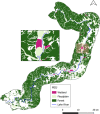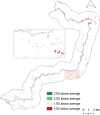Identifying Spatial Patterns and Ecosystem Service Delivery of Nature-Based Solutions
- PMID: 35262773
- PMCID: PMC9012718
- DOI: 10.1007/s00267-022-01613-y
Identifying Spatial Patterns and Ecosystem Service Delivery of Nature-Based Solutions
Abstract
Compared to technical infrastructure, nature-based solutions, NBS, strive to work with nature and to move beyond business-as-usual practices in order to address societal challenges such as flood risks. This research aims to spatially identify possible NBS areas and evaluate the areas capacity to provide selected ecosystem services, ES, for the Lahn river landscape in Germany. The research follows the functional landscape approach using hydromorphological landscape units, HLU, based on specific biophysical spatial criteria, such as slope, to then identify locations which may be considered suitable for NBS. The current ES delivery of these possible NBS areas is then evaluated. The three ES assessed are carbon storage, nutrient retention and recreation. We then undertake a geospatial comparison analysis to show the spatial relationships and patterns that emerge in regards to the ES configuration of the distinct NBS apt areas. Results show the HLU method serves to delineate and identify areas where NBS may exist or be implemented. The data depicts a distinct spatial pattern for each possible NBS space and complementary ES delivery. This explorative method is a useful spatial approach that can support NBS implementation and serve to investigate the multiple benefits NBS provide. The use of ecosystem services to compare and understand NBS is a viable prospect that must, however, be cautiously, locally and scientifically approached. Noticeable limitations regarding ES assessment remain, as available methods are often insufficiently inclusive of natural ecosystem processes and functions. Further research should assess a broader spectrum of NBS and their delivery of ES.
Keywords: Ecosystem services; GIS; NBS; Rivers; Spatial analysis.
© 2022. The Author(s).
Conflict of interest statement
The authors declare no competing interests.
Figures










References
-
- Albert C, Schröter B, Haase D, Brillinger M, Henze J, Herrmann S, Gottwald S, Guerrero P, Nicolas C, Matzdorf B. Addressing societal challenges through nature-based solutions: How can landscape planning and governance research contribute? Landsc Urban Plan. 2019;182:12–21. doi: 10.1016/j.landurbplan.2018.10.003. - DOI
-
- Andersson E, McPhearson T, Kremer P, Gomez-Baggethun E, Haase D, Tuvendal M, Wurster D. Scale and context dependence of ecosystem service providing units. Ecosyst Serv. 2015;12:157–164. doi: 10.1016/j.ecoser.2014.08.001. - DOI
-
- Aylward B, Bandyopadhyay J, Belausteguigotia J-C, Börkey P, Cassar A, Meadors L, Saade L, Siebentritt M, Stein R, Tognetti S, Tortajada C, Allan T, Bauer C, Bruch C, Guimaraes-Pereira A, Kendall M, Kiersch B, Landry C, Mestre Rodriguez E, Meinzen-Dick R, Moellendorf S, Pagiola S, Porras I, Ratner B, Shea A, Swallow B, Thomich T, Voutchkov N (2005) Freshwater ecosystem services. In: Millenium ecosystem assessment: ecosystems and human well-being: current state and trends. Island Press, p 213–255
-
- Beichler SA. Exploring the link between supply and demand of cultural ecosystem services—towards an integrated vulnerability assessment. Int J Biodivers Sci Ecosyst Serv Manag. 2015;11:250–263. doi: 10.1080/21513732.2015.1059891. - DOI
MeSH terms
LinkOut - more resources
Full Text Sources
Research Materials
Miscellaneous

